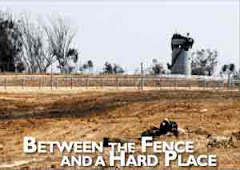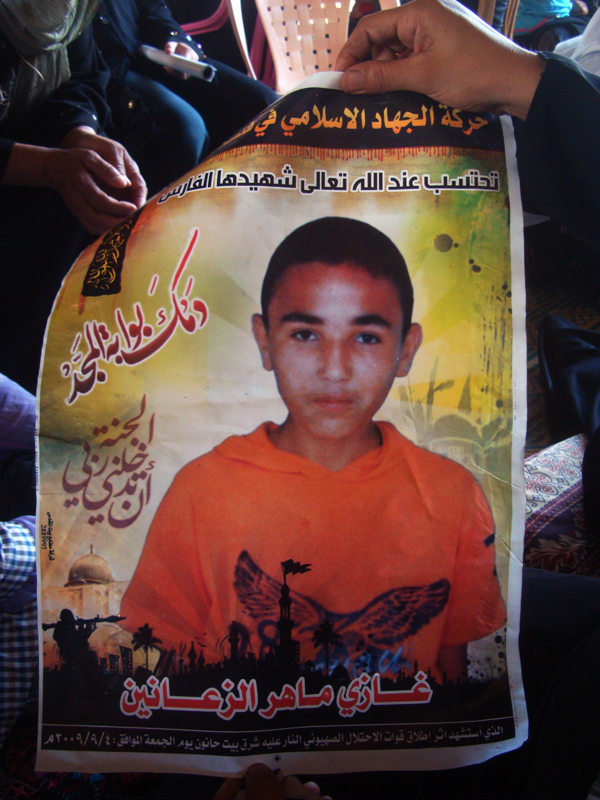By Donna Wallach
Al-Faraheen, Abasan Al-Kabeera, Gaza Strip, Palestine, 12th November 2008
On Wednesday 12th November, five international volunteer Human Rights Observers, most of them members of ISM Gaza Strip, went to Al-Faraheen, east of Khan Younis to pull weeds in the radish garden at the farm of Jaber Abu-Rageliyah and Leila Abu-Daga and their five children, and to establish an international presence. They live on a farm just 700 meters from the fence which separates Gaza Strip, Palestine from Israel. It is a very dangerous area for them to live and farm.
On 1st May 2008 Israeli occupation force soldiers invaded Al-Faraheen Abasan Al-Kabeera and destroyed all the trees, crops and chickens on Jaber’s farm – ruining his livelihood and denying him and his family the healthy organically homegrown food they eat. Israeli occupation force soldiers have been destroying farms all along the eastern border of the Gaza Strip, 300 – 500 meters deep, to enforce an arbitrarily declared “Buffer Zone”. Every tree, every crop, every chicken farm, every sheep farm and every hot house within this area bulldozed, demolished destroyed – this agriculturally rich soil made into a desert for hundreds, if not thousands, of Palestinian farmers. They are still denied their right to farm their lands and are often shot at when attempting to. Jaber has been shot at numerous times in the past weeks for weeding his now tiny garden just 100 meters from his farmhouse.
On this warm autumn day, a few volunteers arrived early and met Jaber waiting at the gate outside the temporary house where his wife and daughters spend the night. The windows to the farmhouse have been shot out and it is now too cold for them to sleep there. Jaber and his young son sleep in the farmhouse each night to establish their presence and to protect it from possible demolition.
Leila and the two youngest daughters greeted their guests and in traditional Palestinian hospitality invited them to a delicious breakfast of yogurt, olives, babaganooz, homemade bread, hawayig (a special Palestinian jam) and of course very sweet tea. Finally it was time to go to work, pulling weeds in the radish garden.
As soon as the volunteers began pulling weeds they witnessed at least three jeeps driven by Israeli occupation force soldiers on the road along the border fence. The soldiers often stop their jeeps, get out and lie on the ground and shoot at unarmed Palestinian farmers who have come to their fields to work. All the farmers are struggling to return to their farms to provide a livelihood and sustenance for their families. There are also towers built every 5 kilometers along this fence and armed Israeli occupation force soldiers sit in these towers and shoot at and spy on Palestinians who live in the area.
Very soon more HRO volunteers arrived and joined the weed pullers. After a while amidst the chatter, the newer volunteers wanted to see the banner hung on the destroyed chicken-house, next to the radish garden, it says “International Presence” in big black letters. The banner is hung each time the volunteers come to the farm. This day, as the volunteers stood looking out towards the destroyed fields and the border fence, they noticed that soldiers had gotten out of the jeeps. Almost immediately the soldiers opened fire. One of the volunteers quickly went to get the bright yellow reflective vests that some of them wear when they work in the fields in the “Buffer Zone”. Two volunteers used the bullhorns they had brought and were yelling to the Israeli soldiers: “Stop shooting!” “We are unarmed!” “Palestinian farmers have the right to farm their land!” This time the shooting only lasted a few minutes.
Soon-after the HRO volunteers noticed lots of gunfire and explosions in El-Gerrara, another small farming community to the north of Al-Faraheen. Then they heard and saw two helicopters in the sky. A quick phone call revealed that special forces of the Israeli occupation force army had invaded El-Gerrara and the resistance fighters were battling against the invasion, to protect the people and the land from this illegal incursion. Later on the volunteers learned that four young Palestinian men had lost their lives defending the lives and the land of El-Gerrara – all were deeply loved by their families and friends who are now mourning over this very big loss and sacrifice. All the men were 30 years old and younger and were married with young children at home.
As soon as the shooting and explosions were over, all the volunteers, Jaber, and his friends resumed pulling weeds, but much time had passed and soon the Human Rights Observer volunteers had to leave. Only half of the radish garden had been weeded. There were enough volunteers to have finished the weeding that day, but too much time was wasted during the shooting. Such is the every day existence of the Palestinians, life is always interrupted by the Israeli occupation force soldiers, the occupation and the siege.



